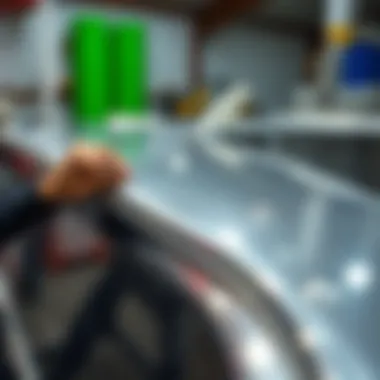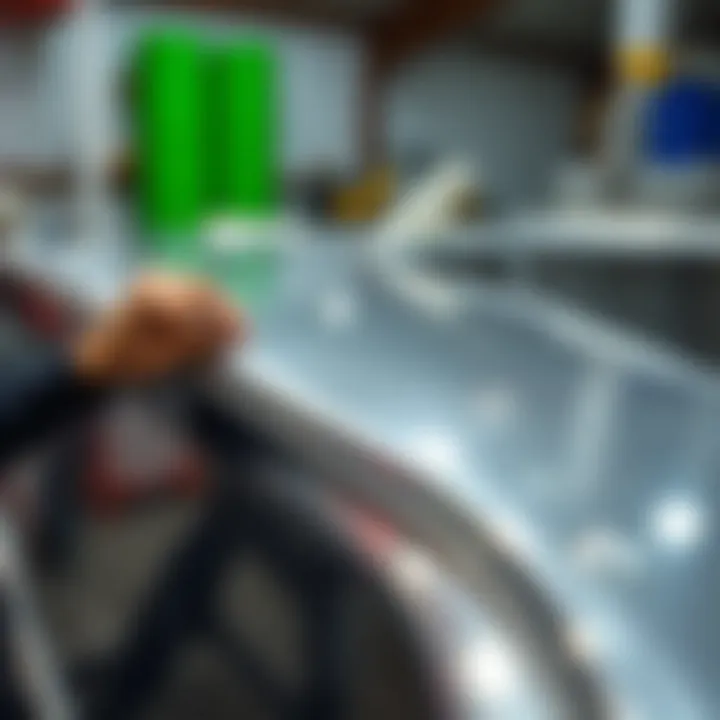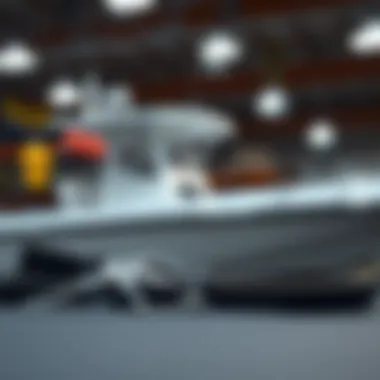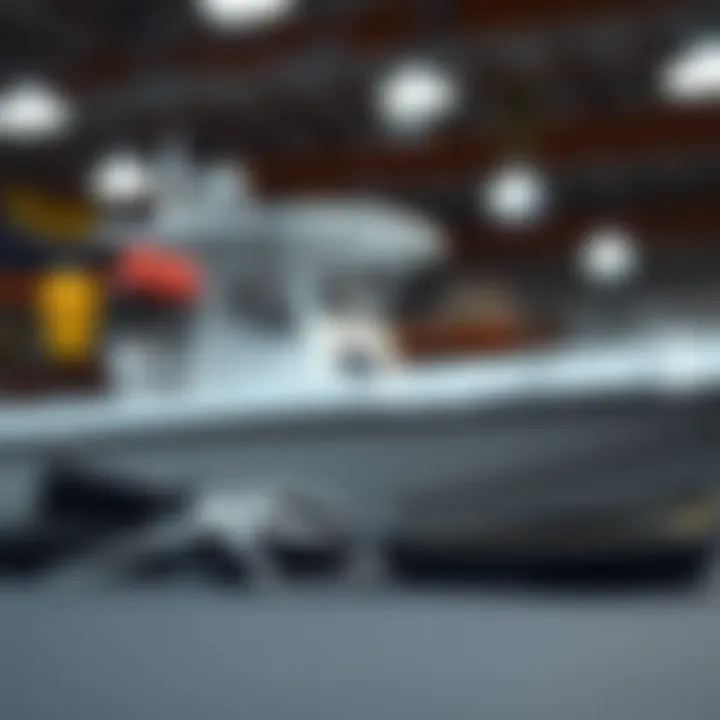Expert Guide to Replacing Rivets on Aluminum Boats


Intro
Replacing rivets on aluminum boats is more than just a routine maintenance task; it’s a crucial step to ensure the longevity and safety of your watercraft. Aluminum boats, known for their light weight and corrosion resistance, often rely on rivets to maintain structural integrity. Over time, due to exposure to water and the elements, these rivets can weaken or corrode, which may threaten the entire vessel.
In this guide, we will navigate through the intricate process of rivet replacement. With a keen focus on safety and technique, we aim to equip boat enthusiasts with the tools and knowledge needed for effective maintenance. Whether you are a seasoned sailor or a novice looking to keep your boat shipshape, this guide will provide valuable insights into the rivet replacement process. We’ll cover everything from choosing the right materials and tools, to executing the replacement with precision.
By following the step-by-step instructions outlined here, you can ensure your aluminum boat remains in optimal condition for adventures on the water. Let's embark on this journey to keep your vessel afloat and performing at its best.
Understanding the Importance of Rivets in Aluminum Boats
When it comes to aluminum boats, rivets are more than just fasteners; they're linchpins that hold the entire structure together. Understanding their role means grasping how they contribute to the overall integrity and functionality of a vessel. The primary purpose of rivets is to secure two or more pieces of aluminum, ensuring stability and safety while on the water. Over time, the significance of proper rivet maintenance becomes evident, as neglecting them can lead to serious issues.
Role of Rivets in Structural Integrity
Rivets act like arteries in a boat's anatomy, distributing stress and managing load across the hull. Each rivet works tirelessly to prevent movement that could lead to leaks or structural failure. For aluminum boats, which are prized for their lightweight and durability, the choice of rivets is critical. The wrong rivet or poor installation can compromise the integrity of the vessel. In fact, well-placed rivets can extend the lifespan of your boat dramatically.
One of the most interesting aspects is the way aluminum rivets respond to stress. Aluminum has a tendency to expand and contract with temperature changes, and rivets are designed to accommodate this movement. If they’re installed correctly, they allow for flexibility and can absorb the vibrations from waves or engine operations, keeping the boat stable.
"A single faulty rivet can turn a wonderful day on the water into a nightmare."
This highlights how crucial rivet integrity is to any sea-going adventure. Think about it: you wouldn't drive a car with loose screws, so why would you want to venture out on a boat with compromised fasteners?
Common Issues with Rivets Over Time
As with any material, rivets are not immune to wear and tear. Over time, several factors can contribute to the degradation of rivets, including corrosion, physical stress, and environmental elements. Saltwater, in particular, is notorious for eating away at metals, and aluminum is no exception. This can lead to pitting and, if left unchecked, eventual failure of the rivet itself.
Another major issue involves natural vibrations from the boat's operation. Over years of initial smooth sailing, rivets can loosen, causing an unsettling rattle that may signal deeper structural issues. Furthermore, when boats are left unused for long periods, it's not unusual for rivets to collect moisture and, consequently, rust.
In summary, understanding the importance of rivets can lead to better maintenance and, ultimately, a safer boating experience. The health of a boat relies substantially on the small yet vital components like rivets that hold everything together - quite literally!
Identifying When Rivet Replacement Is Necessary
Knowing when to replace rivets is a crucial part of maintaining aluminum boats. Ignoring rivet issues can lead to more significant problems, such as structural weakness or water infiltration, which can jeopardize the safety and longevity of your vessel. Addressing rivet conditions promptly can save you a boatload of trouble down the line, ensuring that your aluminum boat remains watertight and structurally sound.
Signs of Damage or Wear
Identifying signs of damage or wear on rivets can be a game changer. Regular inspections are your best ally here. Keep an eye out for:
- Corrosion: Look for white or greenish residue, which indicates oxidation. It’s a red flag.
- Rivet deformation: If rivets appear bent or misshapen, they may be compromised and unable to hold their intended loads.
- Separation: Check if any rivets are actually pulling away from the boat material. This can be a sign of significant wear.
- Visible cracks: Hairline fractures can grow over time, so don’t overlook them.
If you spot one or more of these issues, it’s time to consider replacing those rivets.
Assessing the Extent of Damage
Once you've identified signs of wear, assessing the extent of damage is essential to determine whether replacement is necessary. This requires a bit of detective work.
To start, inspect the affected area closely:
- Use a Magnifying Glass: This can help you detect fine cracks or corrosion that you might miss with the naked eye.
- Check Adjacent Rivets: Sometimes problems with one rivet can indicate an issue with others nearby. Any weak rivet could compromise the structural integrity of the whole joint.
- Tap Test: Lightly tap rivets with a small hammer and listen for the sound. A dull thud could suggest that the rivet is loose or has lost grip.
- Pull Test: For a more hands-on approach, try gentle pulling on the rivet head. If it moves or seems unstable, it must be replaced.


"Catching issues early can prevent cascading failures that endanger the safety of your boat and crew."
After assessing, if it's evident that the damage is localized, you might only need to replace a few rivets. However, if several are compromised, a more extensive repair may be in order, possibly requiring professional help. Don't cut corners—when it comes to safety on the water, you want to put your best rivet forward.
Essential Tools and Materials Required for Rivet Replacement
When it comes to replacing rivets on aluminum boats, having the right tools and materials is not just a convenience; it's essential for achieving a durable repair. If you endeavor into this task without the appropriate instruments, you may find yourself stuck midway through or, worse yet, compromising the integrity of your boat's structure. Here, we explore the tools and materials necessary for rivet replacement, emphasizing their importance and benefits to ensure a successful project.
Types of Rivets Suitable for Aluminum
Rivets come in various styles, but not all are suitable for aluminum applications. Here are some types that stand out:
- Blind Rivets: These are perfect for scenarios where access is limited. They're easy to install with a rivet gun and provide a strong hold.
- Solid Aluminum Rivets: For traditionalists, these rivets offer fantastic fatigue resistance and are often used in applications requiring high strength.
- Self-Setting Rivets: Ideal for quick installations, they allow for speedy repairs without fussing over the application process.
Choosing the right rivet is half the battle won. It ensures that the structural integrity is upheld, and that the repair will last.
Tools Needed for the Job
Having the right tools can make or break your rivet replacement project. Here’s a detailed breakdown of what you need:
Rivet Gun
A rivet gun is the primary tool for installing rivets. This device allows you to grip rivets firmly and apply the necessary pressure to set them correctly. A key characteristic of a quality rivet gun is its ease of use, which is crucial, especially for novice boaters. While there are manual options available, powered rivet guns can significantly reduce the effort required, making them a popular choice.
"Using a powered rivet gun means you can focus more on precision and less on brute force."
A unique feature of some rivet guns is their interchangeable heads, allowing you to adjust for various rivet sizes. This flexibility can be a game-changer when you're dealing with different applications on your boat. However, they can be pricier than manual versions, so consider your budget and needs carefully.
Drill
Securing rivets often involves drilling—this is where a drill comes in. A high-quality drill, preferably a lithium-ion cordless model, helps to ease the process of creating clean holes for new rivets. The key characteristic of a drill suited for this job is its power and durability, especially when working with harder aluminum alloys.
Drills typically have attachments for various drill bit sizes, allowing you to match them precisely to the rivets you're using, ensuring no unnecessary enlargements are made.
A unique feature to look out for is a variable speed setting; this will let you adapt your drilling pace according to the material thickness, which can safeguard against potential errors. However, they may require regular maintenance to keep in top shape.
Safety Gear
Never underestimate the importance of safety when working with tools and materials. Wearing appropriate safety gear is a must to protect yourself from accidents. Essential gear includes goggles, gloves, and perhaps a dust mask.
Key characteristics of good safety gear are comfort and durability. You want to trust that your goggles won’t fog and that your gloves won’t rip when you need them most.
A unique feature such as anti-fogging lenses on safety glasses can make all the difference, especially in varied environmental conditions. Prioritize investing in good quality gear—your well-being is the most important aspect of any repair task.
In summary, having the right tools and materials is crucial for effectively replacing rivets on aluminum boats. With the appropriate rivets, a reliable rivet gun, a sturdy drill, and solid safety gear in your kit, you're well on your way to completing your project successfully.
Step-by-Step Process of Replacing Rivets
Replacing rivets on aluminum boats is not just a task; it’s a vital process that can substantially extend the lifespan of your vessel. Proper rivet replacement ensures not only the structural integrity of the boat but also enhances safety on the water. If this process is taken lightly, it may lead to serious problems down the line, including leaks or structural failures when you least expect it. Understanding each component involved in this process can simplify the task and yield better results.
Preparing the Area for Work


Before diving into the actual rivet replacement process, preparing your workspace is a crucial first step. A clean, organized area not only promotes efficiency but also minimizes risks associated with debris and clutter. First, make sure your boat is on stable ground; ideally, use a trailer or blocks to prevent rocking. Remove any coverings, cushions, or other items that could obstruct your access to the areas needing rivet work.
Ensure proper lighting, as dark corners can hide damage or lead to accidents. Lay down a tarp or a suitable floor covering to collect any debris that may fall during the process, keeping the work area safe and clean. This consideration can save you from unnecessary cleanup later on and help keep your focus where it belongs—on the rivets.
Removing Damaged Rivets
With a clear working area, the next step is to tackle the removal of damaged rivets. Using a drill or a rivet cutter, carefully drill out the stubborn rivet head. Make sure to apply steady pressure to avoid over-drilling, which can damage the surrounding material. As you extract the rivet, it may break into pieces, so take your time and ensure all fragments are cleared from the hole to prevent issues when installing the new rivet.
Some boat enthusiasts prefer using a punch to drive out stubborn rivets before drilling. It's a matter of personal choice, but having the right method for these small, intricate tasks can make a big difference in the overall outcome.
Drilling New Holes for Rivets
Once the old rivets are out of the way, you may discover that the holes have become enlarged or misaligned during removal. This is a critical moment; you want to ensure that new holes are drilled cleanly and accurately for the new rivets. Use a center punch to mark the exact location for drilling. This step reduces movement and ensures precision.
Choosing a drill bit that matches the diameter of your new rivets is essential. Aluminum can be forgiving when drilling, but a steady hand is needed. Drill through the aluminum carefully, ensuring you follow the original hole's center to maintain alignment. After the drilling, always clear away any aluminum shavings or debris. They can affect rivet placement.
Inserting and Securing New Rivets
Now comes the moment to breathe life back into your aluminum boat—installing the new rivets. Start by preparing the rivets according to your chosen method, be it using a handheld pop rivet tool or a pneumatic rivet gun. Each method should be carefully reviewed to ensure it meets the specific type of rivet you are using.
As you insert the rivet, ensure it sits level in the freshly drilled hole. When using a rivet gun, pull the trigger smoothly, maintaining alignment. You’ll hear a distinct sound when it’s secured properly. Make sure to check each rivet for a tight fit; they should not rattle or wiggle. Properly secured rivets will help to protect against water ingress and ensure the boat's structural stability.
Finishing Touches and Inspection
Finally, it’s time for the final touches and inspection. Once all new rivets have been installed, take a moment to clean the work area and remove any tools. This part may seem trivial, but it allows you to focus purely on the newly installed rivets and ensures everything is in order.
Examine each rivet closely—look for any signs they are not properly secured or if there is excess material around the rivet heads. A good practice involves giving a few gentle taps to listen for any irregularities in sound; a solid installation should produce a dull thud rather than a hollow sound. In addition, consider applying a protective sealant around each rivet to enhance further protection from water.
Safety Precautions During Rivet Replacement
When tackling the job of fitting new rivets on an aluminum boat, safety should never take a backseat. There's a place for ambition and DIY prowess, but it must be balanced with the right precautions. After all, a couple of missteps can lead to injury or costly mistakes that might take the wind out of your sails. It’s vital to protect yourself and the work environment to ensure a smooth and successful rivet replacement process.
Personal Protective Equipment (PPE)
Before getting your hands dirty, gear up. Personal Protective Equipment, or PPE, is a game changer in any repair job. Think of it as your essential armor against the unforeseen. Here are the must-haves:
- Safety Glasses: Don’t underestimate the power of protecting your eyes. Metal shavings and debris can fly around in an instant when drilling rivet holes. A good pair of safety glasses is your front line against unwanted injuries.
- Gloves: Wearing gloves serves a dual purpose—protection against sharp objects and improved grip on tools. Look for cut-resistant gloves that will shield your hands while still allowing you to handle the delicate components of the rivet work.
- Dust Mask: If you’re drilling into aluminum, there’s going to be some dust. A dust mask is necessary to keep those fine particles out of your lungs, especially if you’re sensitive to allergens or irritants.
- Ear Protection: The sound of drilling can be piercing. Prolonged exposure to loud noises can take a toll on your hearing. Wearing ear protection will keep your auditory senses intact.
Having the right PPE doesn’t just help you do the job; it provides peace of mind. Once geared up, you can focus more on the task at hand, rather than worrying about what could go wrong.
Work Area Considerations
The right environment can make a world of difference. Setting up your workspace with intention saves time, reduces potential hazards, and overall enhances efficiency. Here are some important considerations for your workspace:
- Clean and Organized Space: Start with a clear workspace. Clutter can lead to accidents, and misplaced tools can be a real headache. Lay out your tools and materials neatly—this way, you won't have to search high and low while trying to replace those rivets.
- Proper Ventilation: If you’re working on your aluminum boat indoors or in a tightly enclosed area, proper ventilation is crucial. Opening doors or windows helps ensure fresh air circulates, keeping the dust and fumes at bay.
- Stable Surface: Make sure your boat is secure. If you are working on a trailer, ensure it’s on level ground. Any shifts or movement can result in mishaps.
- Lighting: Good lighting is key to spotting small details. Dimly lit spaces can lead to mistakes. Ensure that your workspace is well-lit, allowing you to see exactly what you're doing and making it easier to spot potential safety hazards.
Remember: A safe environment minimizes risks and increases your efficiency during the rivet replacement process.
Taking the time to equip yourself with proper PPE and establishing a safe, organized work environment sets the stage for a successful rivet replacement project. This attention to detail not only ensures your physical safety but also elevates the quality of your work.


Common Challenges in Rivet Replacement
Replacing rivets on aluminum boats can be quite the task, and it comes with its own set of challenges. Understanding these common challenges not only prepares you for what lies ahead but also helps in executing the job with finesse. This section delves into two principal hurdles: dealing with corroded rivets and working in tight spaces. Each presents unique considerations that require attention, making it vital for boat enthusiasts to be well-informed.
Dealing with Corroded Rivets
Corrosion can sneak up on any boater, much like a shadow in the night. Aluminum, while resistant to rust, can still suffer from galvanic corrosion when it interacts with dissimilar metals. This can make removing affected rivets a bit of a conundrum.
When faced with corroded rivets, it’s important to tread carefully. First, assess the extent of the corrosion. A simple visual inspection might do the trick, but when the rivet is all but unrecognizable, you’ll need to employ some clever techniques. Start by applying a penetrating oil to loosen the rivet. Give it time to work its way into the nooks and crannies; patience here is key. If that doesn't budge it, consider using a rivet extractor—a tool specifically designed for situations like this.
"The most challenging rivets can often be removed with just the right technique and tools, so don’t lose heart if it seems daunting!"
If the corrosion has progressed excessively, you may need to drill out the rivet completely. No need to panic—just be sure to drill carefully to avoid damaging the surrounding aluminum. Once you've gotten rid of the old rivet, clean up the area before installing new ones. It's best to make sure you address the root cause of the corrosion too, like ensuring proper dissimilar metal separation and applying protective coatings in the future.
Working in Tight Spaces
Another common ordeal is working in tight spaces. This might be the moment when you wish you had an extra pair of arms. Space constraints can make even seasoned boat repair aficionados feel like they’re trying to thread a needle in a hurricane. The cramped quarters around a rivet can limit the kinds of tools you can use and complicate the entire replacement process.
Here, careful planning is essential. Before you start, ensure that you have the right smaller tools handy. A compact rivet gun, for instance, can be a lifesaver. You don’t want to find yourself in a sticky situation halfway through where your tool won’t fit!
Even the method of insertion may need adjusting; while it’s usually straightforward, in narrow areas, you might have to twist and tweak your approach. Sometimes, it’s the smallest adjustments that yield the best results. Using a flexible drill bit can also help navigate those awkward angles. Keeping everything organized will reduce frustration and streamline your work process.
These challenges can be overcome with a little preparation and the right mindset. Although it may not always be smooth sailing, arming yourself with knowledge and adaptability can make rivet replacement not just doable, but rewarding.
Maintenance Tips to Prevent Future Rivet Issues
Maintaining the integrity of rivets on aluminum boats is not just a one-time job; it's an ongoing commitment to ensure your vessel stays in top shape. Over time, wear and tear can compromise rivet performance, leading to leaks and structural damage. Therefore, taking proactive steps in maintenance can save boat owners a great deal of hassle and expense in the long run.
Regular Inspections
Keeping an eye on your boat’s rivets can really make or break the longevity of your boat. It's all about being vigilant; after all, an ounce of prevention is worth a pound of cure. Regular inspections help detect issues before they snowball into major problems.
- Inspect the rivets every few months, especially after heavy use or exposure to harsh weather.
- Look for signs of corrosion or looseness. A rivet that's out of place could indicate underlying issues that need addressing.
- Check surrounding areas as well; sometimes rust can spread like wildfire if not caught early enough.
Finding a small problem sooner not only preserves the life of the rivets but can also enhance the overall stability of the boat. By attending to minor repairs promptly, you improve the chances of avoiding costly repairs down the line.
Applying Protective Coatings
Using protective coatings is like giving your boat’s rivets a sturdy raincoat against the elements. Aluminum boats can suffer from exposure to moisture, which often leads to corrosion. A good quality protective coating can act as a barrier, significantly minimizing these damaging effects.
- Types of coatings: Consider using epoxies or marine-grade paint designed for aluminum. These products stand up well against both freshwater and saltwater.
- Application method: Properly prepare the surface; clean it thoroughly to remove dirt, grease, and old coatings. Applying the new coat in even layers ensures better adhesion, leading to longer-lasting protection.
- Frequency of reapplication: Review manufacturer's guidelines, as some coatings may require annual touch-ups, while others can last longer.
By incorporating protective coatings into your regular maintenance schedule, you protect not just the rivets but the entire hull of your boat. Just imagine reducing the risk of leaks and the associated headaches that come with them!
"A stitch in time saves nine." This old saying rings true when it comes to boat maintenance. Regular inspections and protective measures offer long-term benefits, allowing you to enjoy your time on the water without worry of unexpected failures.
Closure
In summary, replacing rivets on aluminum boats is more than just a repair job; it’s a vital maintenance task that ensures longevity and safety. A well-executed rivet replacement serves to preserve the structural integrity of your boat and keeps it seaworthy, ultimately protecting your investment from the harsh elements encountered while out on the water.
Recap of the Rivet Replacement Process
When approaching the rivet replacement, it’s important to follow a systematic process. First, identify any signs of damage that necessitate replacement. Look for loose, corroded, or missing rivets. Next comes the essential preparation: clearing the work area, gathering tools, and ensuring your safety gear is in place. Once you're set, proceed by removing the damaged rivets, drilling new holes if necessary, and securing the new rivets correctly. Don’t forget the finishing touches, like double-checking your work and inspecting for any overlooked issues. Each step plays a critical role in ensuring that the boat remains in optimal condition.
Encouragement for DIY Enthusiasts
For those of you who delight in getting your hands dirty and embarking on DIY adventures, take heart! Tackling rivet replacement might seem daunting, but with the right tools and a bit of patience, it can be a rewarding experience. Keep in mind that each rivet you replace is a step toward better performance and durability of your vessel. Don’t shy away from seeking resources or advice from other boat lovers, whether through forums like reddit.com or educational websites like britannica.com. Much like fishing, practice makes perfect. Your boat will thank you for your efforts, and you’ll gain invaluable skills along the way.



